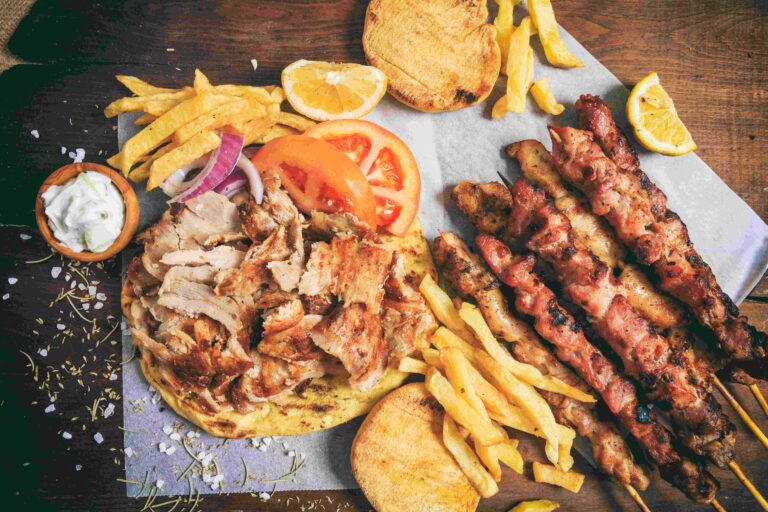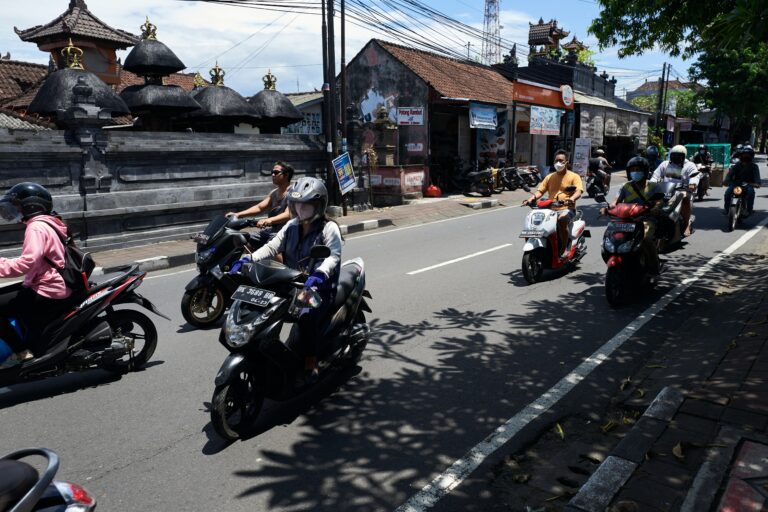Nyepi is the New Year holiday of the Balinese people. It’s famous for being a day of silence, and it’s a unique cultural experience. However, the night before Nyepi celebrations is anything but silent. It’s when the Ogoh-Ogoh come out to play.
Ogoh-ogoh parades can be a real highlight of a trip to Bali for people who love Balinese culture and the towering figures of terrifying effigies make for an incredibly memorable experience.
So, let’s take a deep dive into what the Ogoh-Ogoh are and why the Balinese folk spend a day carrying evil spirits around their peaceful island.
About Ogoh-Ogoh
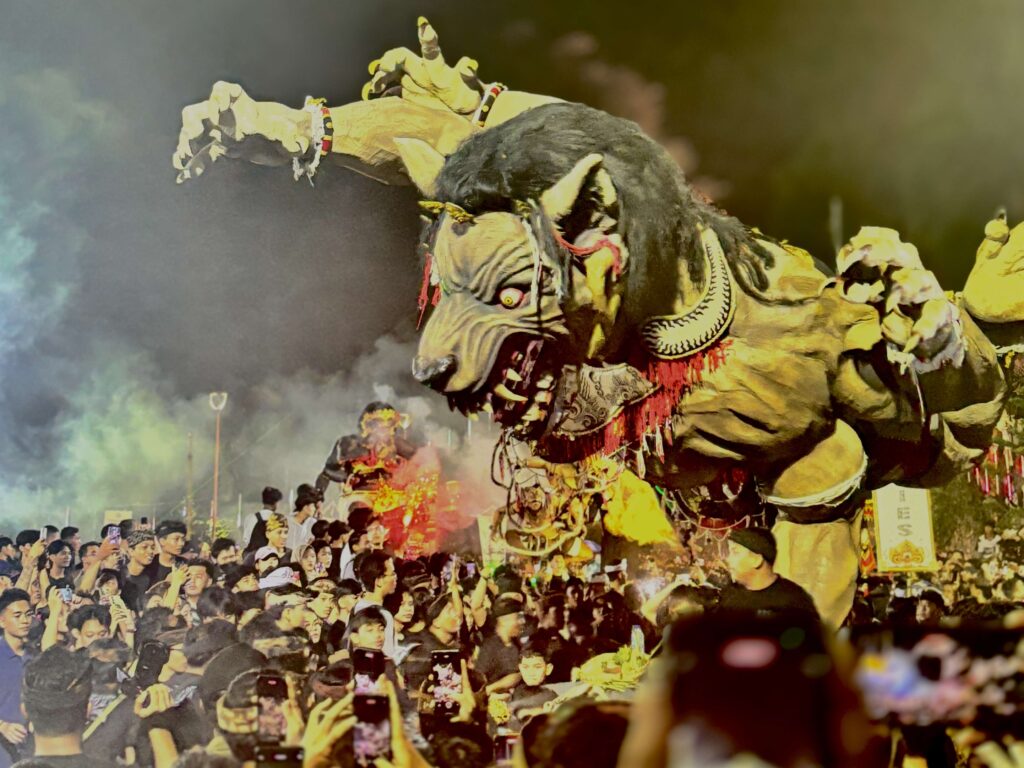
The Ogoh-ogoh are an art form born from sculpture. Once a year, on Pangrupukan (the day before Nyepi), the Ogoh-Ogoh are brought out for Ogoh-Ogoh competitions and for Ogoh-Ogoh parades.
It is a tradition that comes from the Tawur Kesanga (the rituals of Nyepi) that is meant to stop negative energies from manifesting in the following year.
The Ogoh-Ogoh are said to symbolise the evils that lie within the hearts of men and the negative forces of the universe as a whole. So, when the parade ends and the loud drumming has died down, the Ogoh-Ogoh are burned to prevent any trace of them remaining in the New Year.
The Ogoh-Ogoh that you see in the Ogoh-Ogoh parades are each made in their own banjar (neighbourhood) and there are some common themes that can be found in the shapes that are used.
Butakala – is a supernatural demon of the “lower realm” in Hindu mythology and is meant to represent the worst of what lies within human beings.
Mythological animals – any creatures from Hindu literature or from the wayan kulit (shadow puppet plays) are fair game to become Ogoh-Ogoh
Hindu gods and goddesses – obviously not all gods and goddesses are suitable to be used as Ogoh-Ogoh, but those with the most negative associations for the Balinese are often selected
The Ogoh-Ogoh are made from various materials, but the usual choices are bamboo, rattan and occasionally styrofoam frames that are then covered in paper.
It’s no simple task to make an Ogoh-Ogoh statue, and a craftsman may work for months on a single statue!
One thing you should know is that Ogoh-Ogoh parades aren’t as traditional as many portray them to be. While the concept of the Ogoh-Ogoh has deep-seated roots in the local culture since ancient times, the parades are very new and the first appears to have taken place in the 1980s.
The Ogoh-Ogoh parades appear to have been inspired by lelakut (local scarecrows), pelebonan statues and the fearsome Barong of myth.
However, that they’re relatively recent doesn’t change the fact that they are enthusiastically celebrated in Bali now, and Ogoh-Ogoh competitions are held each year to pick the very best examples of Balinese creativity.
The Meaning Of “Ogoh-Ogoh”
The word “Ogoh-Ogoh” is derived from the Balinese language (this is distinct from Bahasa Indonesia, which is the language of the archipelago) and comes from the word “Ogah”, which means “to shake”.
Thus “Ogah-Ogah”, which means shaken over and over again. It refers to the way that, during the procession, the Ogoh-Ogoh statues are shaken throughout the evening as they are walked through the villages to seem like they’re involved in a dance.
As with the parades, the term “Ogoh-Ogoh” is relatively new. The first recorded use of the phrase is in the Bali Post newspaper of March 6, 1984!
Before that, they appear to have been called “onggok- onggok” which meant “raised repeatedly” rather than shaken.
History Of Ogoh-Ogoh
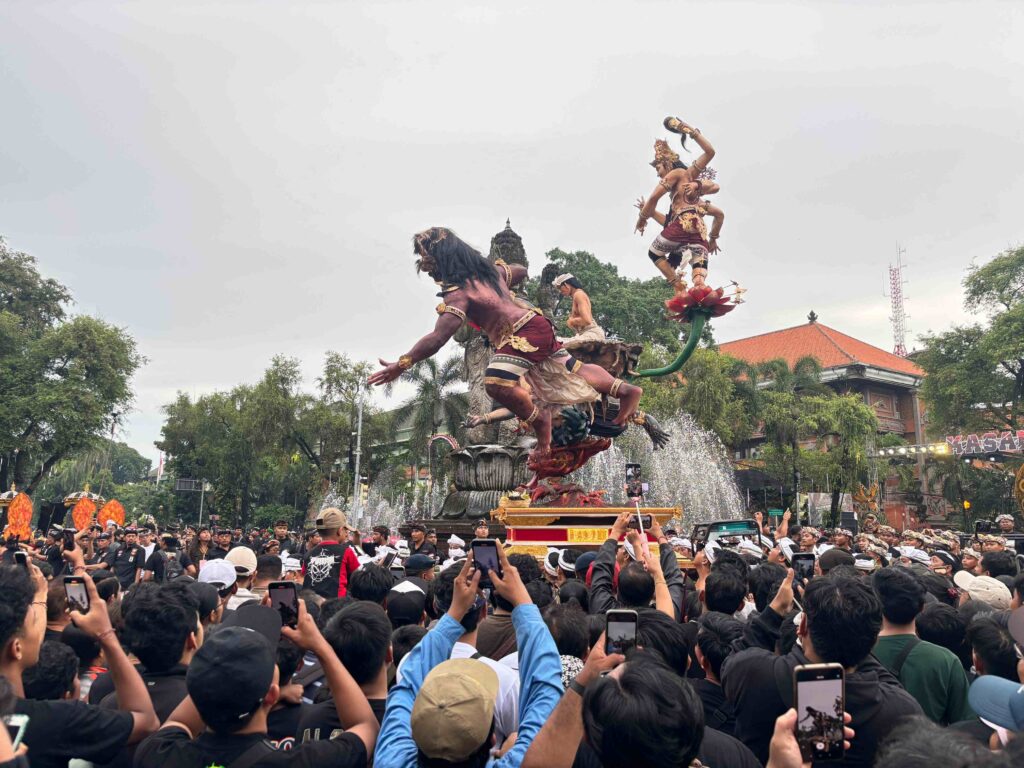
While the Ogoh-Ogoh parades are new, as previously indicated, the practice of creating a giant statue for processions is an authentic experience from Balinese history.
Originally, such statues were used in cremation ceremonies for royal and noble houses (and for Hindu Priests). Colin McPhee, the Canadian composer who spent much of his life in Bali, records the use of such figures in 1933.
The Barong Landung (a noble mythological creature) was also made into a giant puppet and paraded through the streets.
Before the introduction of Ogoh-Oogh, the night before Nyepi celebrations appears to have been celebrated very differently; the Balinese Hindu community would make caru (ritual offerings), light torches/fires of coconut leaves, scatter aromatic spices, and make loud noises.
It appears that the original inspiration for Ogoh-Ogoh emerged from a small village in the Puri Kesiman area, where the people burned a scarecrow which was displayed at the village crossroads.
Over time, the locals invested more and more often in personifying these evil spirits, and thus, the Ogoh-Ogoh were born.
When the tradition began to break out in Denpasar, the local authorities were quite resistant to the idea of Ogoh-Ogoh parades, but the popularity of the parades with young people soon saw their objections overruled.
Nyepi, itself, was declared a national holiday throughout Indonesia in 1983, and that saw the Ogoh-Ogoh parades gain a huge boost in popularity.
Throughout the 1990s and 2000s, the Ogoh-Ogoh parades grew ever more sophisticated, as did the models the Balinese used.
However, this also drew the watchful eye of local government to ensure that no significant aspersions were cast by the design of the statues on anyone’s character.
The quest to make the most interesting Ogoh-Ogoh saw styrofoam catch on as a popular building material in the 2010s, but this was banned by the government.
They also banned the use of sound systems at Ogoh-Ogoh parades and instructed the Balinese to use traditional gamelan instruments instead.
In the pre-Covid era, the government left it until February 2020 to announce their restrictions on the parades, by which time many people had already made their Ogoh-Ogoh. Nonetheless, the parades did not go ahead, though a slimmed-down form of Nyepi ceremonies was allowed to take place without the parades.
Bans remained in place for 2021 and 2022, but the parades returned in 2023 and were, once again, a huge hit with local people and visitors alike.
How Are Ogoh-Ogoh Made?
The Ogoh-Ogoh are built by the banjar, which is a local community unit of a given neighbourhood. These often involve local youth under the watchful eye of older, wiser figures in the community.
They begin making the Ogoh-Ogoh from bamboo or rattan, which is woven to make a framework. However, it’s worth noting that the most complex Ogoh-Ogoh may use an iron framework, which serves as “bones” to support a much heavier structure than usual.
The frame is then covered in layers of paper that are adjusted to make the right thickness of the exterior. Then, they add decorations of fur, fibre, and even jewellery.
In recent years, organic materials such as leaves and tree bark have become popular in some banjar.
An Ogoh-Ogoh statue typically stands between 1 meter and 8 meters tall and can weigh from 100 Kg to 1,000 Kg (1 metric ton)!
A simple Ogoh-Ogoh takes around 1 month to make, but a complex one can take a team of men up to 5 months to complete!
What Do Ogoh-Ogoh Look Like?
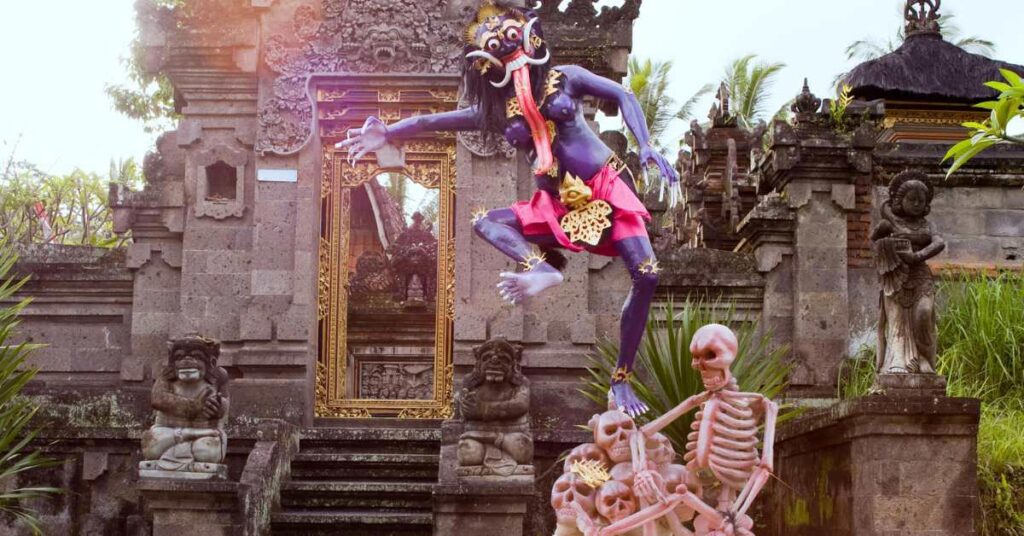
The basic idea is that an Ogoh-Ogoh should be terrifying to look at and that means they represent the evils and falsehoods of our world.
They are burned in a ritual after the parade to ensure that all their negative traits leave this world.
Originally, the Ogoh-Ogoh were all demons from myth, but today, pretty much any negative character can be used, particularly from Balinese folklore and from Hindu myth.
It would be considered very bad form if an Ogoh-Ogoh were to be made to represent something noble or good.
One thing worth knowing is that the Ogoh-Ogoh have become an artform in Bali and people have used them as satirical jests poking fun at politicians or even to protest specific environmental issues.
The Ogoh-Ogoh Parade – Its Meaning And Philosophy
The purpose of the parade is to eliminate negative traits from the island and to transform them into positive energy.
This comes from the Bhuta Kala (stories of human awareness of the power of time and the universe around us) and the Bhuana Agung and Bhuana Alit (macrocosm and microcosm, respectively).
However, some Hindu scholars argue that the Ogoh-Ogoh, instead of pacifying evil spirits, tend to reawaken them, instead.
They point to the fact that this parade, which may delight tourists, has no basis in scripture.
Where To Enjoy Ogoh-Ogoh Parades In Bali

There are many awesome places to enjoy Ogoh-Ogoh parades around Bali, and as long as you behave appropriately, this is one Hindu festival on the island where outsiders are very welcome, indeed.
In fact, tourists often say that the vibrant colors and huge statues are a major feature of their holidays.
Some of the most popular parades include:
Puputan Square in Denpasar – this is the biggest and most official parade on the island. It draws massive crowds and the best statues. However, you need to get there super early to get a good view and getting out afterwards can be challenging.
Jalan Legian in Kuta – this is a very rowdy parade, and the local community really goes all out to purge the evil spirits from Kuta’s nightlife district. Just be warned that it can get very packed and claustrophobic at times.
Central Ubud or the Monkey Forest Road – there are two good places to watch Ubud’s thoughtful and cultural take on this tradition. It’s much less wild than the two celebrations above. However, it can get very crowded here too.
Eat Street in Seminyak – if you want a more laid-back environment where you can enjoy some food and drinks while you soak up the atmosphere, this might be the place to do it. We’d suggest that if you’re staying in Seminyak, there’s no better spot to enjoy this grand event.
Berawa and Batu Bolong, Canggu – the villages in Canggu are all about this tradition, but it’s more chilled than the busier spots and it’s very popular with tourists and expats, particularly those with children who want to enjoy the rituals without being crowded.
Taman Kota Tabanan – if you want the bigger Ogoh-Ogoh on the island, this is the place to be. It’s much less touristy, and you’ll find that this is a raw expression of village festivity.
Pasar Gianyar (Gianyar Market) – This is just outside of Ubud and has the advantage of being a bit quieter than the main town. We love the artistic creativity on show at this festival.
Jalan Diponegoro, Singaraja – North Bali, is a little bit more relaxed around Nyepi, and there are fewer parades to choose from. This one in Singaraja is great, though, and it feels super authentic.
Toyapakeh, Nusa Penida – the Nusa Islands are small islands off the coast of Bali, and while they do celebrate the Ogoh-Ogoh ceremonies, they are a little more muted than on the mainland.
Pecatu Village, Uluwatu – this route leads to the famous Uluwatu Temple (home of the epic fire dance,) but it’s very spread out and can be confusing for tourists.
Klungkung, Semarapura – if you want a heavy touch of tradition on your Ogoh-Ogoh parade, this former royal seat is a great place to enjoy the parades.
Amlapura, Karangasem – this is a very small parade but with an emphasis on community. You’ll find that there’s a very powerful spiritual element to things here.
Danau Tamblingan, Sanur – it’s Sanur, so this parade is positively laidback and chill. It’s a nice place for families with small children to enjoy the event, and the main gathering point is McDonald’s.
Pulakio Temple, Pemuteran – this peaceful village is a great spot to enjoy the event in Northern Bali. Head to Pulaki Temple and enjoy some real bonding with local people.
Batur, Kintamani – you get a nice, dramatic walk through the villages down to the lake in this area. It’s one of the most scenic parades on the island.
How To Prepare For An Ogoh-Ogoh Parade
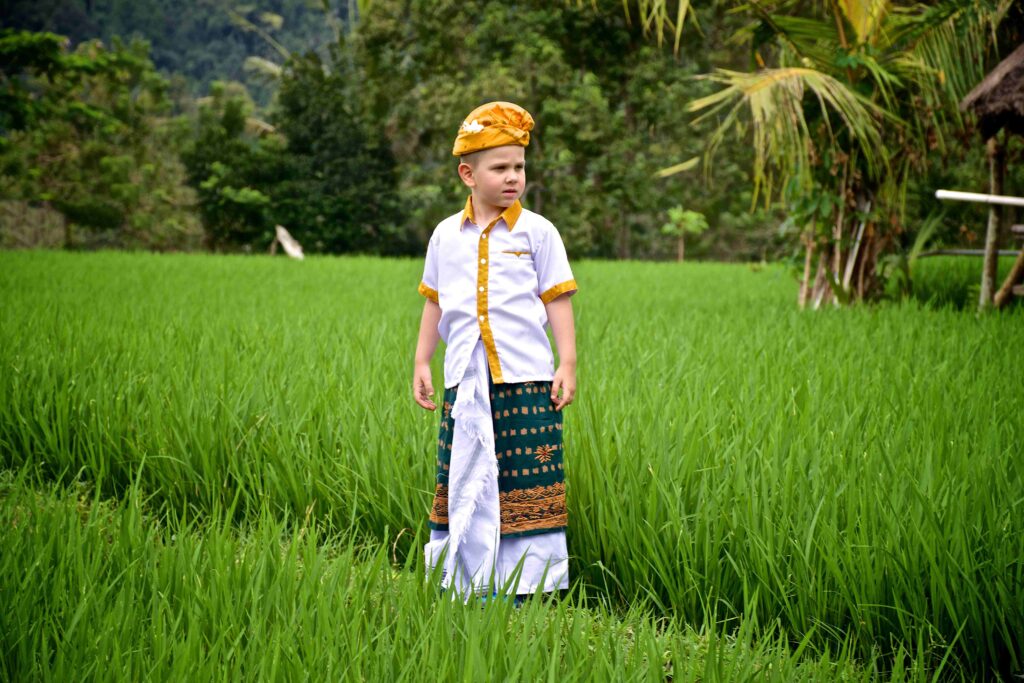
You don’t need to do very much to join in the parade festivities. But you should:
Get there before things start – that’s before 6 p.m. in some areas and before 4 p.m. at the busiest places. You should know that these parades can go on until midnight, too.
Dress appropriately – there’s no uniform to be worn at these parades, but it’s always nice to wear a sarong in keeping with local customs. You should also wear light, breathable clothing and never wear revealing clothing. A bikini or sports bra, for example, will give offence.
Understand you are there to watch, not to participate – the parade itself is for local youths, it’s not for foreigners to take part in. You can watch and enjoy the celebration, but don’t try and get more involved.
Safety & Etiquette At The Ogoh-Ogoh Parades
There aren’t many safety tips and etiquette tips you need to know but these may help:
Children – kids are always welcome at these events, but if your little ones are very little, it’s best not to take them to places like Denpasar, Kuta and Ubud, where things can get a bit hectic. Head to Canggu, instead.
Entrance fees – there are no entrance fees at Ogoh-Ogoh parades, and if someone asks for one, they’re scamming you. It’s a community event that takes place every year, everyone is welcome.
Photography – you may take as many photos as you like, but be nice about it. If you’re in a smaller village setting, particularly, it’s best to ask permission before you shove your camera in someone’s face.
Be Respectful – nearly everything boils down to this, this is a semi-religious festival, and that means it’s important to be nice and respectful throughout. Have fun and enjoy yourself but make sure that your fun isn’t impinging on anyone else’s good time.
How To Deal With Rain During The Parades

Given that the statues are made of paper, they don’t tend to mix well with the rain.
So, while in most cases, if it rains the show will continue, it may be postponed if there’s a heavy downpour or be shortened to accommodate the weather.
Where To See Ogoh-Ogoh Outside Of Bali?
Ogoh-Ogoh parades are also found in other parts of Indonesia, though they are not practised by Indian Hindus.
You can find them in Tenggara, Lampung, East Kalimantan, Lombok, South Sulawesi and East and Central Java.
Interestingly, if you want to enjoy an Ogoh-Ogoh parade in Europe, there is a community of Balinese expats based in Brussels, Belgium adn they regularly hold these parades to celebrate Nyepi with the blessings of the local government.
You may also find the term “Ogoh-Ogoh” used around Indonesia simply to refer to any large-scale representation of a mythical creature or demon.
These representations are secular and don’t have any purpose in the Hindu religion.
These “Ogoh-Ogoh” have also featured in international parades in places as far apart as Tasmania, Den Haag and Tokyo.
Some people mistake the Vijayadashami Hindu Festival in India for an Ogoh-Ogoh parade, but this festival marks the victory of Rama over Ravana as laid down in the Hindu epic, the Ramayana. It’s not a New Year holiday like Nyepi.
FAQs
What Is The Meaning Of Ogoh-Ogoh?
“Ogoh-Ogoh” literally means “shaken repeatedly”, but the term refers to the use of large statues to represent evil spirits and negative energy.
What Is The Ritual Of Ogoh-Ogoh?
The ritual of the Ogoh-Ogoh is a parade through the streets of Bali (and some other places in Indonesia) to rid the island of negative forces the day before the New Year holiday of Nypei.
What Is The Ogoh-Ogoh Festival In Bali?
The Ogoh-Ogoh festival marks the day before Nyepi in the Balinese calendar and is a ritual to rid the island of evil and negative influences.
Where To See Ogoh-Ogoh In Bali?
There are many great places to see the Ogoh-Ogoh festival in Bali, but the best parade is the one in Central Denpasar.
What Happens On Nyepi Day In Bali?
Nyepi is the Balinese festival of silence. Everyone on the island is expected to stay at home, stay inside their home and be quiet for a day.
The island effectively shuts down for this day (including the airport) and it’s against the law to be outside for any purpose other than getting to or from a hospital.
However, many resorts and hotel complexes do allow their guests to use the pool and restaurant facilities on this day.
Is There An Ogoh-Ogoh Parade In The Gili Islands?
No, there is no Ogoh-Ogoh parade in the Gili Islands. These islands are a part of Lombok and not Bali.
The area is almost exclusively Muslim and not Hindu, and thus, they don’t celebrate Nyepi in the Gili Islands.
The Nusa Islands, on the other hand, are part of Bali and do celebrate Nyepi and do have Ogoh-Ogoh parades.
Final Thoughts On The Ogoh-Ogoh
The Ogoh-Ogoh may be a relatively new tradition, but it is celebrated with sincerity and good hearts on the island of Bali.
For those who come to Bali for the period of the New Year, the Ogoh-Ogoh is an exciting, vibrant affair that can’t be found anywhere else on Earth.
It’s exciting to be able to take part in a ritual that rids the island of eveil for a year and helps to usher in a year of peace and prosperity for everyone in Bali.
Related blogs:







